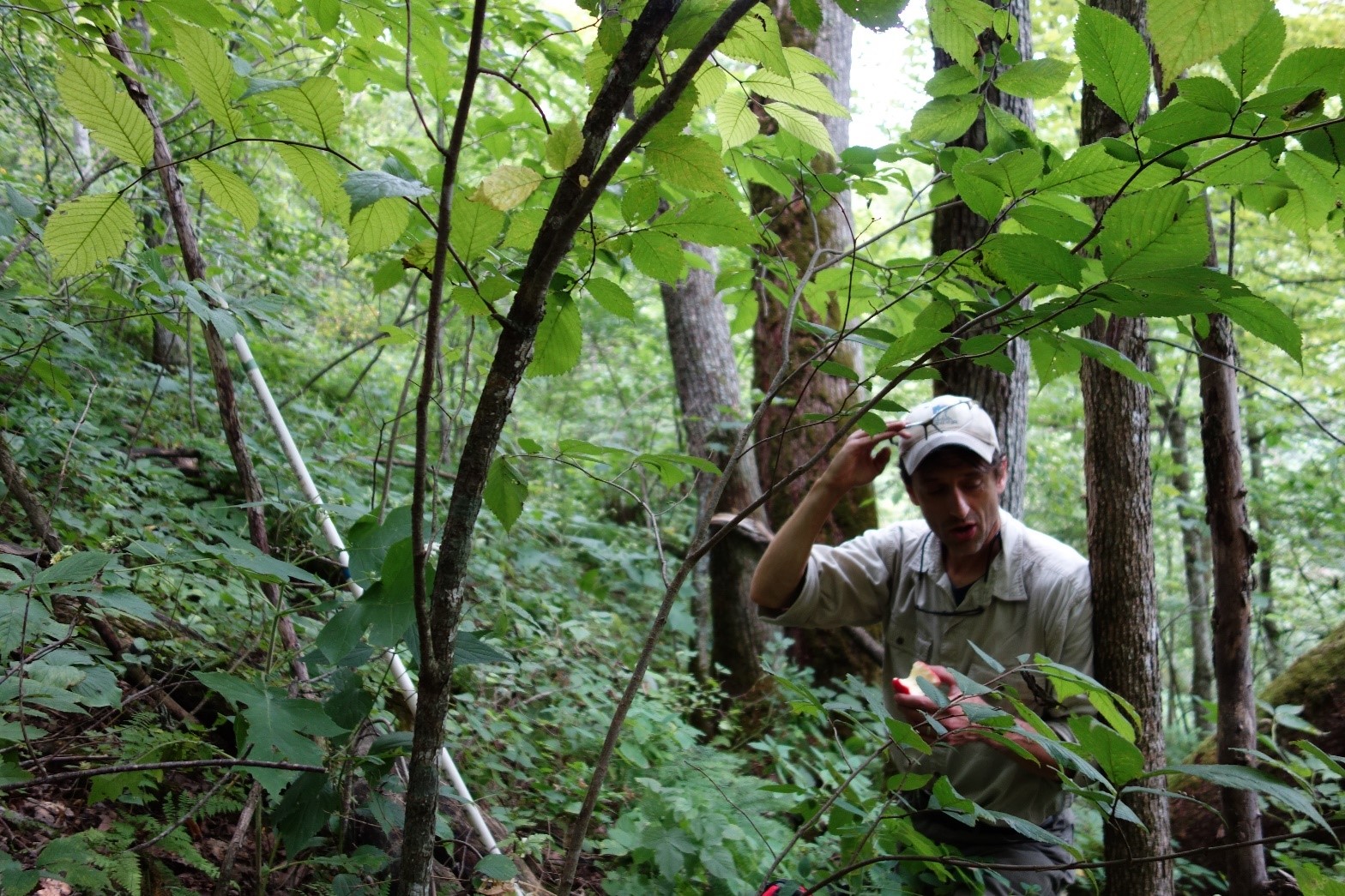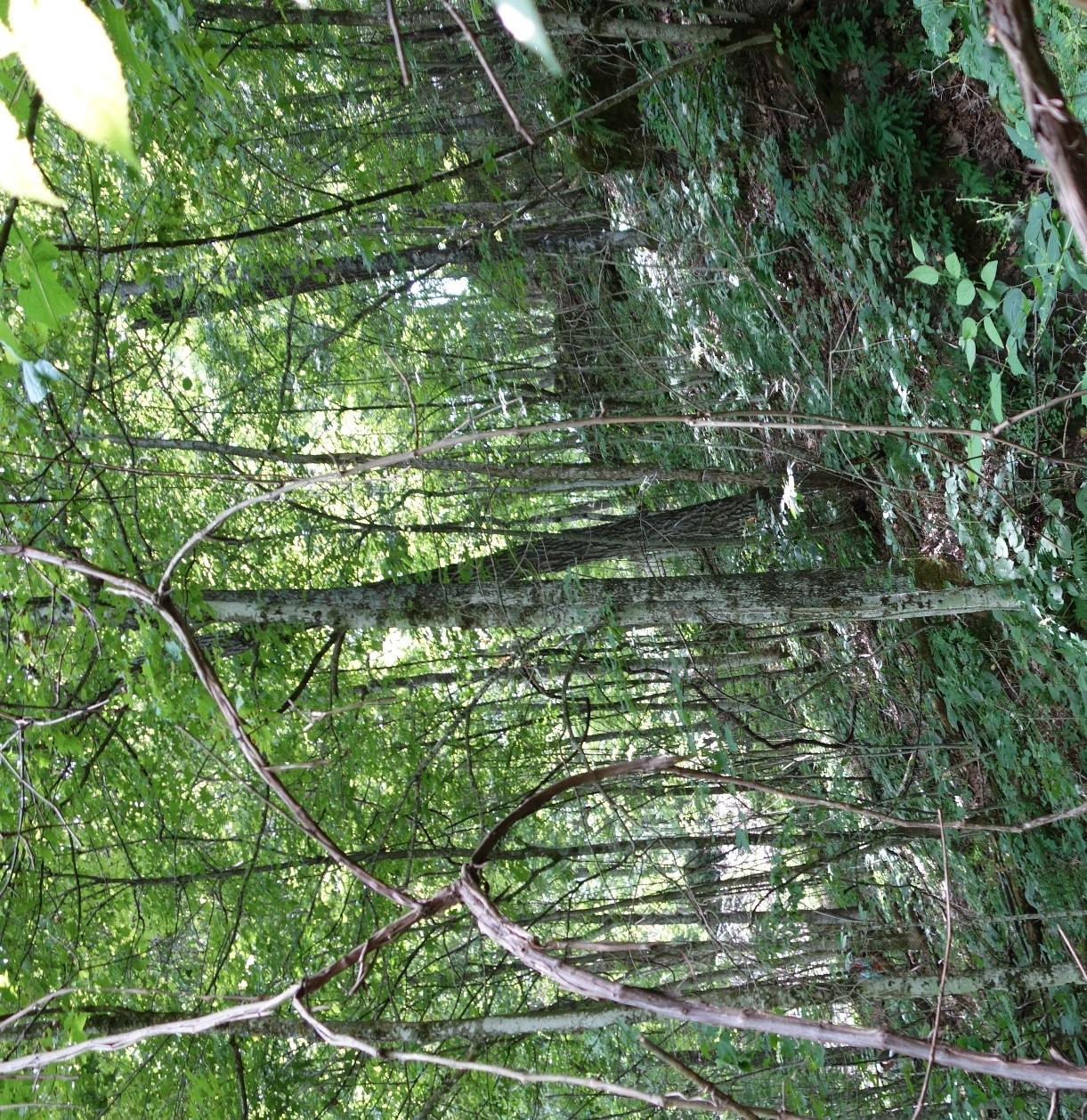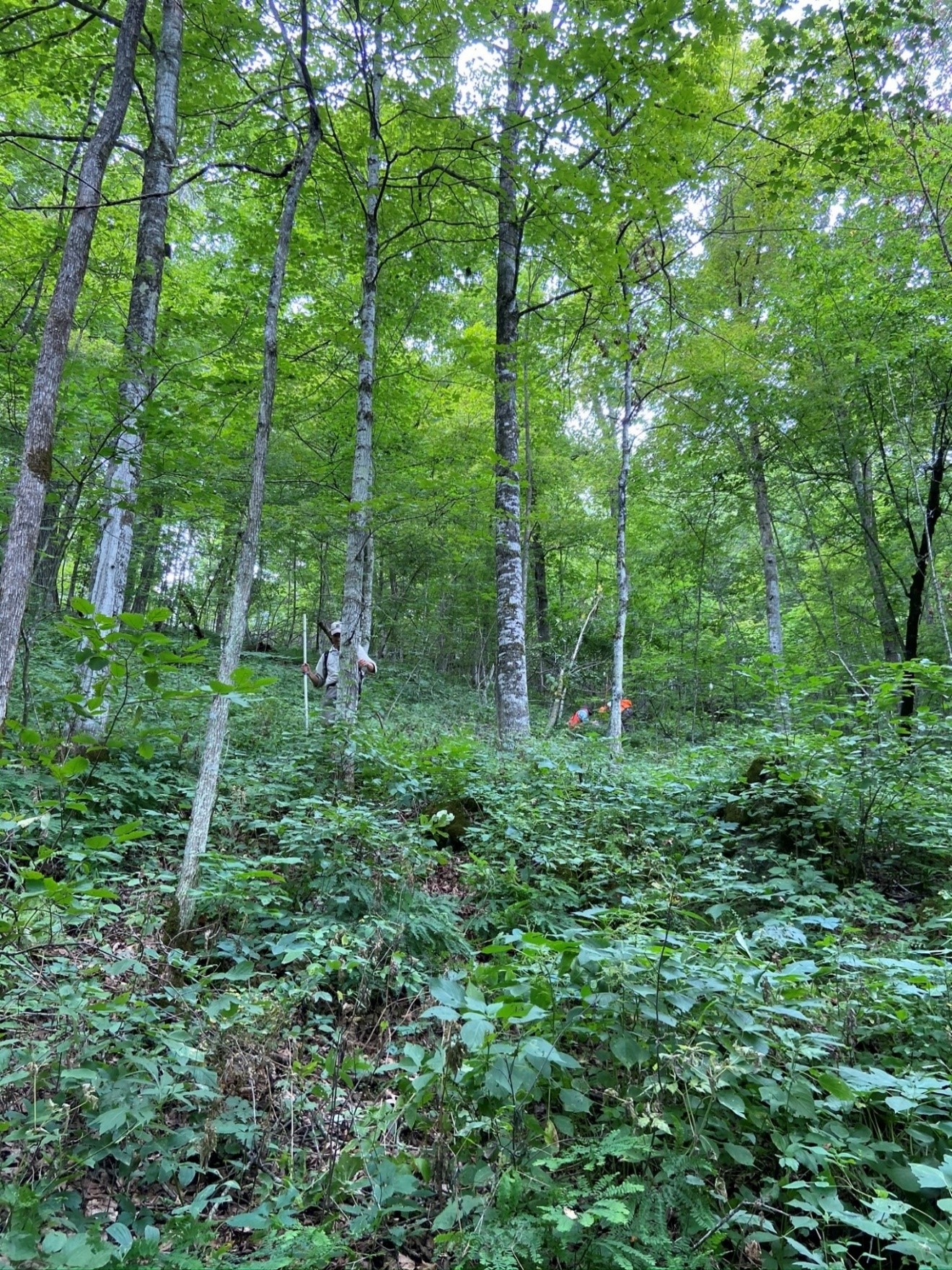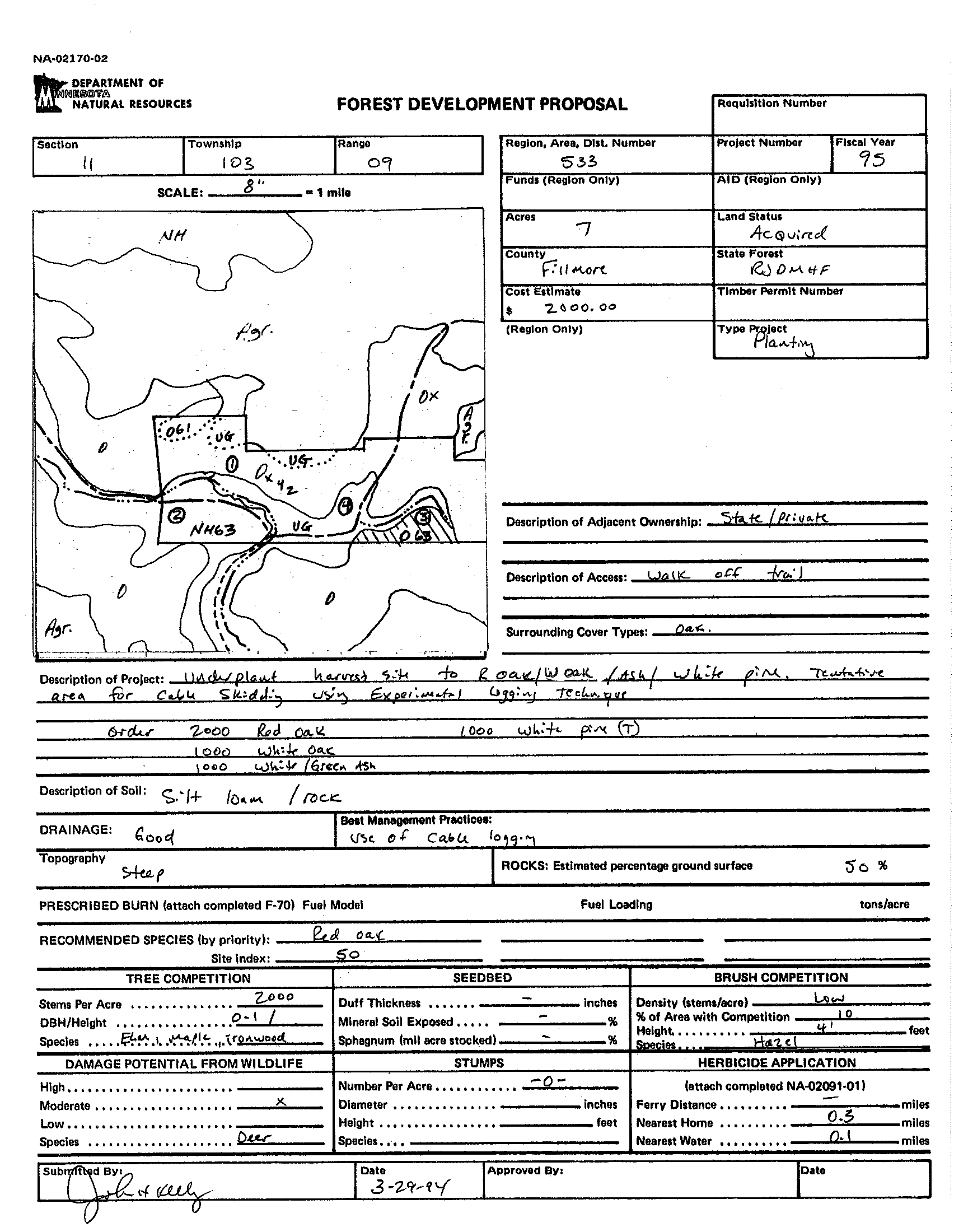Overview
This case study documents stand conditions 25 years after an experimental hi-lead cable skidding system was used for harvest on a very steep, mesic forest site. The stand was one of several sites that were subjects of the publication “Evaluation of a Cable Yarder Harvesting Steep Slopes in Southeastern Minnesota's Bluff Country" authored by John Sturos, Michael Thompson, Charlie Blinn, and Rick Dahlman; this publication can be downloaded in the Supplemental Content section.
The main objective of the cable skidding was to reduce soil disturbance impacts. It also enabled harvest of timber on very steep slopes not easily accessible with a conventional cable skidder. Regeneration of an oak component similar to the mature stand was one of the silvicultural objectives of the harvest and other silvicultural activity.
The result of the project is a healthy, diverse northern hardwoods stand dominated by sugar maple and basswood, with smaller amounts of red and bur oak, bitternut hickory, elm, hackberry and black cherry and several others. Similar to a number of other studies of regeneration activity on mesic sites, we did not get nearly as much oak regeneration and recruitment to larger size classes as we had hoped.
Details on management practices, current stand composition, costs and revenue are presented in the study.
Silviculture Objectives
- Regenerate a mature oak stand to a young stand of similar composition.
- Perform a field trial of a cable skidding system designed to enable access to timber and reduce soil compaction and erosion on steep sites.
- Maintain and improve wildlife habitat with a strong component of oak trees in the new stand. Oak forests provide habitat for numerous wildlife species. One of oak's most important contributions to wildlife is mast, or acorns which are an important seasonal food source for squirrels, turkey, deer, grouse, blue jays and other acorn consumers.
- Improve timber quality and value. A good component of healthy, well-formed fine hardwoods will help ensure high timber value at harvest time.
Pre-treatment stand description and condition
Stand establishment and management history
Most of the mature oak stands in southeastern Minnesota at the time of project initiation originated after control of regular fires after European settlement.
The stand was part of a privately owned farmstead until the state obtained it in the 1960s or 70s. It probably had a history of use as a wooded pasture prior to that.
Pre-treatment species composition
Table 1: 1994 Timber Sale Appraisal Volumes of Merchantable Stems Over 12 Inches DBH by Species and Product
Species and Product | Volume (MBF) |
Red Oak Sawlogs and Veneer | 13.65 |
Basswood Sawlogs | 3.46 |
Black Oak Sawlogs | 1.16 |
Bur Oak Sawlogs | 1.16 |
Sugar Maple Sawlogs | 1.02 |
Elm Sawlogs | .94 |
Bur Oak Sawlogs | .22 |
Black Cherry Sawlogs | .10 |
Ash Sawlogs | .08 |
Total | 21.79 |
Pre-treatment growth and stocking
The site is steep, with several dry washes or coves. Aspect is mostly northeasterly, so it is very mesic.
Pre-treatment forest health issues
None noted.
Landowner objectives/situation
The Minnesota DNR objective for oak forest type acreage at the time of project initiation was to maintain it through regeneration of mature stands.
Silviculture prescription
The following series of treatments were implemented:
Treatment | Date | Description | Acres Treated |
Underplanting | 1994 | The following species and number of seedlings were underplanted at approximately at approximately 8’ x 8’ spacing (715 trees/acre):
| 7 |
Clearcut with Reserves Harvest | 1995 | Clearcut with reserves harvest using hi-lead cable skidding technique to lessen soil disturbance impacts. | 7 |
Crop Tree Release | 2018 | Competing boxelder, elm, ironwood, and hickory trees were killed by girdling with a chainsaw, and applying Tordon herbicide to the girdle wound. | 7 |
What actually happened during the treatment
As far as we can tell now, things went largely as planned during the planting and harvest. Trees were chainsaw-felled and yarded uphill to a landing using a Clearwater brand double-drum skyline cable yarder.
Post-treatment assessment

Figure 1: MNDNR Forester Alex Gehrig surveys regeneration on the study site in the summer of 2020
Observations 25 years after initial treatment
25 years after underplanting and harvest, the stand is diverse, healthy northern hardwoods stand
Measurements in 2020 indicate a diverse, healthy northern hardwoods stand 25 years after the initial regeneration work of underplanting and harvest.
As shown in Table 3, sugar maple and basswood are the species with greatest basal area in trees over 10” DBH. Also present in sizes greater than 10” DBH are red and bur oak, bitternut hickory, elm, hackberry and black cherry. NOTE: Given expected growth rates, as of 2020 trees greater than 10” DBH are all residuals from the 1995 harvesting work, and were not regenerated due to the harvest activity.
As shown in Table 2, sugar maple, blue beech, elm, ash and basswood are the most abundant regenerated species for size classes greater than 1” DBH, up to 10” DBH. The trees in these size classes have largely regenerated after the silvicultural harvesting activity in 1995. Several other regenerated species are also scattered throughout the stand in smaller amounts, including black cherry, bitternut hickory, ironwood, red oak and hackberry.
Table 2: Trees regenerated post-harvest* by species and size class in 2020
Size Class | < 1 foot in height | >1 foot in height and < 1”DBH | > 1” DBH and < 3” DBH | 3” to 5” DBH | 5” to 10” DBH | |||||
Species | Stems/ Acre | Freq | Stems/ Acre | Freq | Stems/ Acre | Freq | Stems/ Acre | Freq | Basal Area (ft2/ac.) | Freq |
sugar maple | 18,000 | 81% | 1,063 | 44% | 313 | 25% | 50 | 25% | 6.2 | 44% |
blue beech | 1,625 | 38% | 688 | 31% | 219 | 19% | 6 | 6% | 0.0 | 0% |
elm | 1063 | 31% | 250 | 13% | 156 | 19% | 25 | 19% | 0.6 | 6% |
ash | 1125 | 31% | 188 | 13% | 188 | 13% | 6 | 6% | 0.6 | 6% |
basswood | 63 | 6% | 188 | 19% | 63 | 13% | 25 | 19% | 1.9 | 13% |
black cherry | 250 | 13% | 63 | 6% | 31 | 6% | 0 | 0% | 0.6 | 6% |
bitternut hickory | 375 | 25% | 0 | 0% | 0 | 0% | 19 | 19% | 1.3 | 13% |
ironwood | 0 | 0% | 0 | 0% | 31 | 6% | 6 | 6% | 0 | 0% |
red oak | 188 | 19% | 0 | 0% | 0 | 0% | 6 | 6% | 0.0 | 0% |
hackberry | 63 | 6% | 0 | 0% | 0 | 0% | 0 | 0% | 0.6 | 6% |
Totals | 22,752 |
| 2,440 |
| 1001 |
| 143 |
| 11.8 |
|
Frequency (Freq) = % of plots with occurrence
*NOTE 1: The DBH classes we used for data collection are helpful, but not perfect for distinguishing post-harvest regeneration from harvest residuals. This is because the 5”-10” DBH class likely contains largely post-harvest regeneration, but also contains some harvest residuals.
NOTE 2: Trees > 1” DBH have greatest potential to recruit into larger size. Continued silvicultural assistance (release) would be necessary for shade-intolerant species such as oak and black cherry to recruit into larger classes.

Figure 2: A view of the heavy northern hardwoods regeneration in 2020, 25 years after harvest

Figure 3: Sugar maple is the dominant mid and overstory species as of summer 2020
We did not get as much oak regeneration as we had hoped for. Additional intermediate treatments would have been needed for more oaks to recruit to larger size classes
In 2020, there are very few oaks that regenerated post-harvest - not nearly as many as we would have liked. While we could not find records of early post-harvest regeneration checks, it is highly likely that there was good initial post-harvest establishment of seedlings due to the pre-harvest planting work, but very few (if any) survive today. The only red oak stem from 1” to 10” DBH we observed on our sample plots was of sprout origin. It is therefore highly likely that additional release work 2 to 12 years after planting and harvest would have been necessary for more oaks to survive and recruit to larger size classes. This finding is consistent with a number of other case studies focused on oak regeneration on mesic forest sites.
Frequency data in Table 2 shows that only about 6% of the site contains oak regenerated post-harvest. Total stem counts in the 3-5 inch DBH class and basal area in the 5-10 inch DBH class are well below minimum stocking standards (Sanders, 1977). Figure 4 and Figure 5 show that oak regeneration abundance is underrepresented.

Figure 4: Stems/Acre of 3” to 5” DBH Size Class Regeneration in 2020

Figure 5: Basal Area/Acre of 5” to 10” DBH Size Class Regeneration in 2020
Table 3: Basal area in feet2/acre for trees > 10” DBH by size class and frequency in 2020. NOTE: Trees over 10” DBH are all residual trees from the 1995 harvest. Grand total BA of trees > 5” DBH: 60.6 ft2/ac.
Diameter Class | 10-15” DBH | 15-20” DBH | >20” DBH | Total BA > 10” DBH | |||
Species | BA | Freq | BA | Freq | BA | Freq |
|
sugar maple | 15.6 | 75% | 1.3 | 13% | 3.1 | 25% | 20.0 |
basswood | 5.6 | 31% | 1.3 | 6% | 2.5 | 25% | 9.4 |
red oak | 1.9 | 13% | 3.1 | 19% | 1.9 | 13% | 6.9 |
bur oak | 5.0 | 31% | 0.6 | 6% | 0 | 0% | 5.6 |
bitternut hickory | 2.5 | 25% | 0 | 0% | 0 | 0% | 2.5 |
elm | 2.5 | 25% | 0 | 0% | 0 | 0% | 2.5 |
hackberry | 0 | 0% | 1.3 | 13% | 0 | 0% | 1.3 |
black cherry | 0.6 | 6% | 0 | 0% | 0 | 0% | 0.6 |
Herbaceous & shrub vegetation was very diverse and healthy
In terms of non-tree vegetation, we observed plants typically found in MHs38 native plant communities, and there was a great diversity of plant species 25 years post-harvest. See Supplemental Table 1 for a list of plants found on the site in August of 2020.
Herbaceous plants we found include leek, blue cohosh, large flowered bellwort, American bellwort, bloodroot, two-leaved miterwort, maidenhair fern, virginia waterleaf, Jacob’s ladder, pointed-leaved tick trefoil, leafcup, lopseed, jack-in-the-pulpit, giant solomon’s seal, wild sarparilla, black snakeroot, and white snakeroot. For shrub species, we found blue beech, eastern wahoo, alternate leaved dogwood, downy arrowwood, ironwood, hazel, American bladdernut, and native honeysuckle. In terms of non-tree species diversity, we observed what appeared to be a healthy and diverse set of understory plants for an MHs38 native plant community. We collected herbaceous and shrub cover data at this site and plan to write up a separate case study on our findings in the future.
Invasive species
We observed buckthorn at low frequency and density. Other invasives observed at low levels include Creeping Charlie and dandelion.
Plans for Future Treatments
Monitor the stand through periodic inventory surveys. Manage as a multi-aged northern hardwoods stand with periodic timber harvests to maintain a healthy, diverse stand and provide habitat and forest product benefits to the state’s citizens.
Costs and economic considerations
If possible, break down by treatment components: Time estimate to lay out / plan, time to harvest, timber sale revenue, site prep or other costs, etc.
Costs
Underplant seedlings: $285/ac. (Estimated. 1994 dollars)
Timber Stand Improvement (TSI) $250/ac. (2018 dollars)
_______
Total costs: $ 635/ac.
Revenue
Timber revenue: $ 426/ac. (1995 dollars)
________
Total revenue: $ 426/ac.
Other notes
We are grateful for the review and editing assistance of MNDNR Silviculture Program Consultant Mike Reinikainen.
This case study was developed with support from the United States Department of Agriculture's National Institute for Food and Agriculture, Renewable Resources Extension Act. Project #2021-46401-35956, principal investigator Eli Sagor, University of Minnesota.
Summary
25 years after underplanting and harvest, the stand is diverse, healthy northern hardwoods stand, including a very diverse and healthy herbaceous and shrub understory
Measurements in 2020 indicated a diverse northern hardwoods stand 25 years after the initial regeneration work (underplanting and harvest). The understory herbaceous and shrub layer is very diverse and healthy.
We did not get as much oak regeneration as we had hoped for. Additional intermediate treatments would have been needed for more oaks to recruit to larger size classes
The component of young oaks regenerated after planting and harvest is well below what we were hoping for. In 2020, there are very few oaks that regenerated post-harvest - not nearly as many as we would have liked – in spite of the site being underplanted with oak seedlings prior to harvest. It is highly likely that additional release work 2 to 12 years after planting and harvest would have been necessary for more oaks to survive and recruit to larger size classes. This finding is consistent with a number of other case studies focused on oak regeneration on mesic forest sites.
The hi-lead cable harvesting system used appears to have met objectives of enabling silvicultural harvesting activity on a very steep site, while minimizing mineral soil disturbance
The authors of the initial study in the mid-90s found that organic soil impacts were similar between cable yarding and tractor skidding, but mineral soil impacts from cable yarding were lower (an average of 6%) than tractor skidding (an average of about 16%) (Sturos et al. 1997). The full publication, titled “Evaluation of a Cable Yarder Harvesting Steep Slopes in Southeastern Minnesota's Bluff Country" and authored by John Sturos, Michael Thompson, Charlie Blinn, and Rick Dahlman, can be accessed in the Supplemental Content section.
Supplemental content
Link to download Sturos et al 1997: Evaluation of a Cable Yarder Harvesting Steep Slopes in Southeast Minnesota's Bluff Country

Supplemental figure 1: Development record for 1995 underplanting project
Supplemental table 1: List of plants found on the case study site in August 2020
Understory | Mid-story | Overstory |
Honewort, Hepatica, Sweet cicely, Chokecherry (Prunus virginiana), Sugar maple, Black snakeroot, Sarsaparilla, Blue Cohosh, Aniseroot, Nannyberry, Tall coneflower, Honeysuckle, Large-flowered Bellwort (Uvularia grandiflora), Zigzag goldenrod, American bellflower, Bloodroot, Blue beech, Jacob’s Ladder, Miterwort, Alternate-leaved dogwood, Black cherry, Virginia Waterleaf, Hairy carrion flower (smilax lasioneura), Basswood, Hackberry, Rattlesnake fern, Buckthorn, False Solomon’s seal, Cow Parsnip, Woodbine, White snakeroot, Bitternut hickory, Heart aster, Pl, Ironwood, Ash, Downy arrow-wood, Prickly ash, Hazel, Baneberry, Golden Alexanders, Bearded shorthusk, Lonicera- native, Riverbank grape, Eastern wahoo (Euonymus), Pointed leaved tick-trefoil, Avens, Giant Solomon’s seal, Jack in the pulpit, Lots of muscle wood, Shining bedstraw, Leek, Leafcup, Lopseed | Basswood Sugar maple Hickory | Sugar maple Bur oak Basswood Bitternut hickory Black cherry |

Supplemental figure 2: Google Earth aerial photo of study site (outlined in blue) and surrounding area
